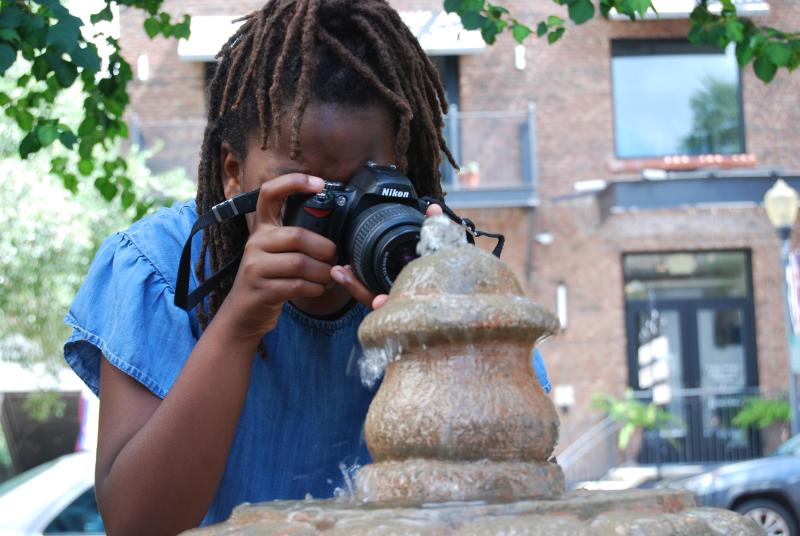ARP Grant Spotlight: United Arts of Central Florida (Orlando, FL)

Crealdé School of Art student in Digital Street Photography for Teens. Photo by John Baker, 2022.
Amid the excitement of mouse ears and theme park rides in Central Florida lies a diverse and colorful cultural tapestry of artists and arts and culture organizations whose futures were put into jeopardy during the pandemic. With corporate, community and national support, United Arts of Central Florida, the area’s local arts agency, helped unlock grants that kept all organizations open and operational throughout the pandemic.
Central Florida is one of the fastest growing regions in the nation and the fastest in Florida at a rate of 25 percent annually. Its diversity is expressed by the wide variety of arts and culture opportunities available to the community, including festivals, murals, and performances where people of all backgrounds can be part of the arts.
President and CEO Jennifer Evins says that United Arts, whose service area covers four counties including Lake, Orange, Osceola, and Seminole, must thoughtfully consider how to serve this large geographic space and unique needs of each county, supporting arts, science, history, and other cultural organizations.
Thanks to federal support through an American Rescue Plan grant from the National Endowment for the Arts, the annual grants that keep Central Florida’s cultural nonprofits running increased by $100,000 and benefited five additional organizations.
In all, 42 arts, history, and science nonprofits received funding through United Arts of Central Florida’s annual operating support grants, more than doubling the agency’s ability to grant prior to the pandemic. The funds are critical to local organizations because they can be used for basic operating needs for uses such as utility bills, staff payroll, and space lease or rental. Since 2019, United Arts has increased the money available by $1 million to reach the $2.4 million approved for the 2023 fiscal year.
“I think the federal support and NEA competitive grant process said that United Arts and this community is worth investing in. That created a lot of positive energy and confidence in our arts community. It felt really good to feel like United Arts was a trusted resource in our community and it was our responsibility to help facilitate other leaders,” said United Arts’ Grants Program Officer, Elyse Jardine.
Evins recalled that the opportunity to distribute non-matching funds that went to operating support made an incredible difference in keeping arts organizations open through the pandemic.
“When you’re on an airplane, they say put the oxygen on yourself and then help those around you. We didn't do that,” said Evins. “We helped everyone else first, which was amazing. We didn't lose one arts organization during COVID and United Arts really starved itself to make sure that everyone survived.”
United Arts also offered an additional level of support to local arts and culture organizations—a community of arts leaders who would meet to discuss pandemic protocols and how to best navigate the challenges they were facing. Together, many of the arts organizations adopted a protocol modeled after Disney’s guidance. This allowed arts organizations to continue performances in a way that was safe and still kept artists in business. The arts organizations also shifted to online programming and offered services virtually.
“I'm really proud of how our organizations were able to pivot during COVID. They thought innovatively about the programs and services they were still offering and how that might look different…National funding is making an impact from a 60,000-foot view, but these local arts agencies can have a really positive impact in a neighborhood or in a community, and we appreciate playing a role in navigating this space,” said Evins.
Convening arts leadership also offered an opportunity for organizations to create a hive-mind and identify gaps in community knowledge.
“Organizations were able to partner together and think about how a strategy may work great in Orange County, but it might not be so great in Lake County or Seminole County, or in what ways might a project be offensive, or is there a different project that can be funded in that community that really serves the people who live there,” said Jardine.
United Arts must be intentional to cultivate and strengthen emerging multicultural organizations that serve underrepresented cultures. We have much work to do to continue to reduce barriers for organizations and people to experience the arts,” added Evins.
The local arts agency sees itself as a conduit between national funding and initiatives and serving at a hyperlocal level, and Evins hopes that future federal funding opportunities will recognize the need for partnership at all levels of community engagement and the emphasis on general operating funds.





